HMS Cardiff, the second Type 26 City Class frigate, made a significant stride in its construction as the forward end of the ship was rolled out of BAE Systems’ ship build hall in Govan.
Following the forward section’s emergence, the aft section is set to roll out in the coming days. BAE Systems’ engineers will soon join the sections together at the Glasgow shipyard on the River Clyde.
Post assembly, the ship will undergo additional structural work before being floated and transported to BAE Systems’ Scotstoun facility in 2024 for outfitting.
The drone flight was fully legal. It was conducted from over the northern bank of the river and a flight plan was submitted. I'm fully registered, qualified and insured to do this. pic.twitter.com/UPwRxDMhtG
— George Allison (@geoallison) June 21, 2023
Simon Lister, Managing Director of BAE Systems’ Naval Ships business, expressed pride and satisfaction in the progress. “The emergence of HMS Cardiff is a very proud moment for everyone involved in her construction. We have now completed all major units of the ship and in the coming weeks our skilled teams will consolidate the ship in preparation for next year’s float off,” Lister said.
He added that the rollout is an “opportunity for us to celebrate the achievement being made with our colleagues, suppliers, customer and the cities of Cardiff and Glasgow.”
The first Type 26 frigate, HMS Glasgow, is currently being outfitted at BAE Systems’ Scotstoun facility. The construction of the eight Type 26 frigates is expected to last to the mid-2030s.
HMS Glasgow is anticipated to be the first of the fleet to join the Royal Navy in the mid-2020s.
HMS Cardiff will be the last frigate to have its hull sections integrated in the open air on the hardstand. This is due to the construction of a new £100m-plus ship build hall at the Govan site, which will allow the integration process for the remaining six ships to take place under cover, making it less susceptible to weather conditions.


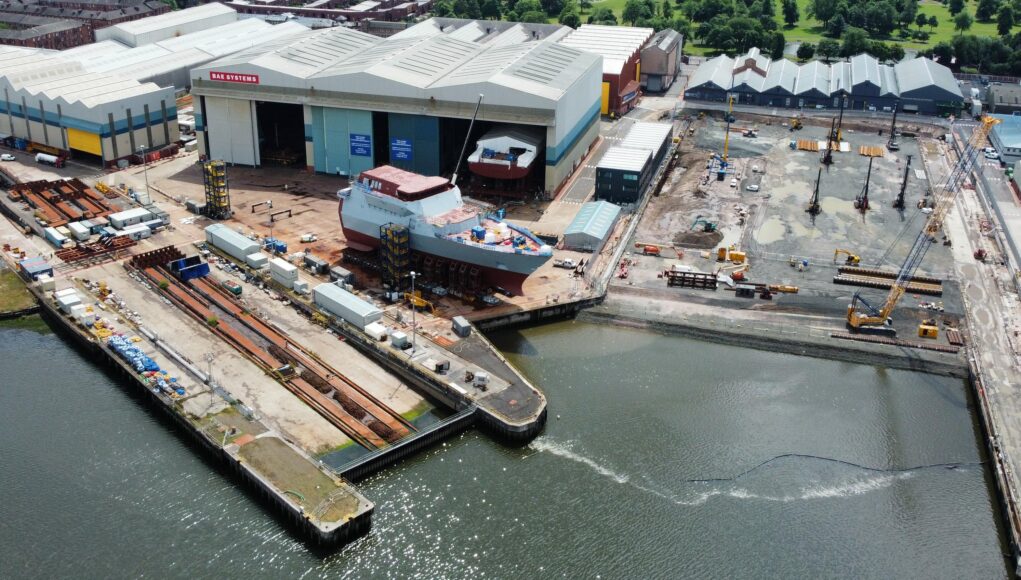

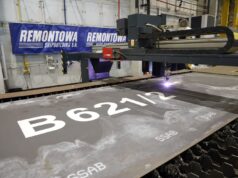
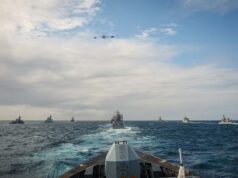



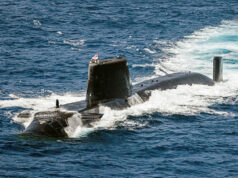

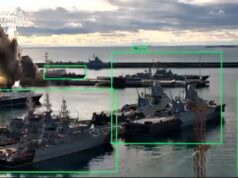
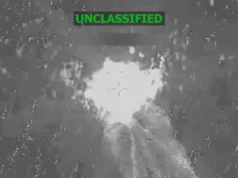


Nice video, as always. And great to see the progress on the build hall next door.
I understand the average build time for a liberty ship was 42 days. Type 26 is obviously more complex however seventy odd years should have advanced our abilities to build quicker & better. There seems to be little incentive to get these ships rolling off the production line and I’m not sure that benefits the RN or British shipbuilding?
Where the liberty ships not constructed using concrete for speed of construction. and used or considered one use unless it survived and could be used again.
Liberty ships were built during WW2, where new merchant ships were required urgently to replace sunken ships in the Atlantic. Not only were they much easier to build than a modern Type 26, there was also the urgent need. The record for a Liberty ship build was approx 4 days but again, a large number of these ships were needed so this build time was possible. Why rush building this Type 26 when you don’t have to, and when the technologies are more advanced, and when these are the first of class? There aren’t the numbers of Type 26 to even think about fast rate production.
Why do we need to build them faster? They are hardly on a go slow and we need time to train the crews to operate them. Building them faster just means we would finish the project quicker and then not have anymore ships to build and then we would lose the skills etc. A steady build rate is a better option. We should basically always be building a ship, that way we keep the skills, knowledge and facilities and can always then ramp up if needed.
The other reason behind ‘slower building’, is that it slows the amount of money that the UK treasury releases on large projects.
True the treasury try to even out capital expenditure to match tax income however if another supplier could supply the need cheaper but in the quantities the RN needed that would be good as well.
We need these ships faster. The whole experiment with the T31 is to get ships faster and in higher quantities for the money available. The business will go to companies which understand the needs of the client – something Henry Ford understood.
The t-31s are not an experiment.. it has been common throughout modern history for there to be a small quantity of advanced equipment and a high quantity of lass advanced equipment. The idea of the t-31 program is not speed of delivery it is cost to build and operate which means more potential assets. The consequence of a cheaper simpler shop is they also happen to be quicker to build but that is not the primary reason for the program.
Imagine if we could commit enough resource to build l the t-26 ships in 1 year. What would that gain us? It would be pointless. We would not have crews to sail them and we would not necessarily get the weapons to arm them quick enough. But most of all we would then have to close down the factory and sack all the workers. We would then lose the knowledge and experience to build them. When we need replacements we would then have to rebuild the whole skills, logistics and construction capability which costs huge amounts.
It is better to plan better and have a constant build program. That way as soon as the last t-26 is out the door we are starting to build the successors.without having to rebuild an entire ship building industry.
The strategy of a constant build program might be great for the supplier when there is a negligable chance of war and we are replacing ships one for one. However perhaps because of the situation in Ukraine we need two or three for one and we might keep the type 23s in reserve as well. Are we saying that our ship building industry is incapable of this?
Not incapable. But that would be the sort of thing you do when you are in a war footing. We are not on a war footing. The ships are being built and the frigates we already operate have been upgraded and are fir for service for some time. Where are the crews going to suddenly come from to operate the type 26s if we accelerate production? We do not need to accelerate production. We need to add more ships to the order but it is not like they are building them abnormally slowly. I am actually quite impressed by the rate of progress. They are now building at the rate of 1 per year which for such an advance ship is great. Remember that it is. It just about building the ship hulls. They need to build very complex systems for fitting etc. We currently have 3 ships under construction at the same time.
You do know that some 100s of class 1 failures haunted the Liberty ships don’t you, 120 alone in one month discovered sometimes when the broke in half, indeed the very first broke in half during construction. They suffered terribly from fatigue but in time of war that was a necessary and sadly acceptable risk. Prior to the war US ship yards built only 70 merchants ships in 7 years so I think a certain perspective needs to followed in terms of ship building capabilities in that period. Welding over riveting, which I hadn’t realised was exploited in German pocket battleships allowed the massive increase in ship production in the US but doing this within serious safety routines is an entirely different question and massively so in the complexities of warships with the added complexity of state of the art systems to be incorporated and thoroughly tested.
😀Yes Spy I was taking an extreme example to make a point. We are not at war yet at the same time perhaps we need to up the slow production of warships to bulk up our numbers especially as, should war break out, the more we have the better. A decade to build a warship is too slow. We need a production line and perhaps our shipbuilding industry is not geared for that. Government might feel better about stumping up the cash for many more ships if we could drive down the cost per unit.
It’s crazy the BAE could not invest the tiny £100 million for the build hall when they are charging over £1 billion a ship for the first batch and have a guaranteed £250 million a year work.
Thank god for Babcock and T31, we really need to keep at least two warship manufacturers going at the same time. Allowing BAE to capture all uk warship production was a mistake.
Hopefully H&W can be brought back in to warship production as well for larger vessels and C&L can start building blocks for AUKUS SSN.
If we get in to a new Cold War with a country as large as china then every slip way will become vital again.
re new cold war, I was watching one of the War Factory programs last night about UK and Vickers during WWII. We massively out manufactured Germany and this was attributed having good non military manufacturing which we could switched. According to the program we went through a boom in the 30s because we lowered taxation which caused a surge in investment, we were also a global country with a global supply chain which meant we had options. Non of these things apply today, high tax, inward looking and limited manufacturing.
Worth a watch.
https://uktvplay.co.uk/shows/war-factories/series-1/episode-3/6082567246001
In 1939 we had to import 90% of our food and much of it from the other side of the planet. We had a massive manufacturing base especially in terms of aircraft but we were completely dependent on imported raw material.
We almost lost the war by starving despite having the largest and most capable Navy on the planet.
Modern weapons are so hideously complicated that no one can produce them with out access to the global supply chain.
It’s completely impossible which is a good thing because it make full scale industrialised war incredibly difficult.
Did you watch the war factory episode? I watched the one of Russian war factories. Staggering amount of Russian actually starved even though they had access to vast resources they couldn’t use them due to miss management by the state again worth watching.
It’s a good find Thankyou….the bolsheviks were a true stain on humanity..it helps you remember why the Cold War happened. It’s Amazing ( in a very sad way) to think how it could be that three of the most profoundly evil empires humanity has managed create all occurred in the same time period. I’ve read a few interesting historians that basically put the rises of these three titans of evil all at the door of WW1…it was as If someone created a “culture of evil” bomb and exploded it across the world.
I think 90% of food imported is a bit high, It was more like 60-70%
Yes I heard we produced about 40% pre war would have thought that through necessity increased during the war but haven’t seen any figures.
Interesting. Few people seem to understand the true integration and inter dependence of the World in all its aspects we just presume life goes on in our own little bubbles. What you state is enlightening. You can add to the fact that ‘Make America Great Again’ is a delusional slogan, the post war scenario that made it fact can no longer be re constructed, far better to remould the great potential still within and celebrate it in a increasing competitive World. Again we all know that China has control of some minerals rear earth intrinsic to modern electronics but till last week I hadn’t realised that virtually all silicon micro chips rely on a base material exclusive to sand in a location in the US. We now have a new Emperor developing in China (who hopefully is seeing how that is going in Russia) and hopefully is being reigned in by the potential implications of disrupting the World Order on all fronts.
Industrial capacity has and alway will be a decider’s in geopolitical struggle. We have lived for some time with an illusion that the next major conflict will be short..it very well may be…but it may also come down to strategic exhaustion ( there is a pretty good body of thought that any Chinese US conflict would drag on until exhaustion or possibly nuclear destruction). In the case of it all grinding to a halt the exhausted party does not tend to hold up their hands and go fair cop gov….they rebuild and come back for round two….and if they rebuild faster than you, your in trouble.
I’ve found the war factories series 1 very interesting. How Germany and Russia failed because they had command economies. Even though the US and UK started from behind, the competitive mentality of industry meant we soon started to out produce them, our production out stripped our losses whilst Germany couldn’t keep pace with its losses because it couldn’t bare to embrace, in the words of the documentary what Hitler thought were ‘Jewish Capitalist’ economic concepts. Russia just produced larger numbers of low quality equipment but also of completely the wrong things and ended up essentially killing large numbers of civilian population through mismanagement and ended up dependent on aid from UK and US. On paper at the start of WWII Germany with superior number and Russia with vast resources should have had a clear advantage.
China is interesting, having embrace some capitalist concepts in industry its still a command political system and to some degree a command economy. But you’re right the next big conflict whoever is loosing the industrial race ie can no longer match it losses could resort to the nuclear option.
BAe are a commercial company and when they were going to build 13 T26 they put plans in place for a new Frigate Factory and merge onto 1 site. That was based on the costs being spread over 13 ships. It was the most efficient way to build that number at the required pace to replace the T23 1 for 1 on their OSD.
But the twin decisions to reduce that build to only 8 and the more relaxed build schedule as per MODS request (treasury payment schedule) meant there was no need to do so.
However with the recent upping of the game and the promise of the follow up T83’s the incentive is now there to do so,hence the work.
I doubt there will ever ever be a hull section of the AUKUS or RN SSN(R) boats built at CL there are many reasons.
Firstly BAe is contracted to build all those boats and due to the new expansion of the Barrow site they will have all the capacity to do it onsite themselves.
Secondly no submarine has been built at CL since the early nineties and the level of quality control, materials being used, tollerences involved etc would require a huge investment in skills, equipment and facilities and it adds nothing other than extra cost.
On the other hand I think CL & Appledore have a bright future, the Amphibious ships will need replacing after the FSSP are completed and as they are warships they will need UK built blocks.
I have no idea what they will look like at moment as MOD seesm to be changing its ideas from one idea to another.
Rodders you do know that CL do some blockwork on the Astutes don’t you. Not full hull sections but inserts that fit inside those hull sections built at Barrow.
No I didn’t know that thank you 😉 My knowledge is more to do with the Derby end of the process. But it makes sense for BAe to sub out some of the internal sections, rafting’s etc.
Good to see CL keeping their skill sets going and I hope they get more work in future.
How are we going to justify 2 shipbuilders beyond the Type 31 without further orders?
Well 5 type 32s aswell so that’s another 5 years of work….
Not in the equipment plan at present. But then nor is Mk41, Type 83 (only a concept) nor a lot of what else people would like to see.
“If” Jim? There’s no “if”, we are in a cold war with the PRC & a tepid one wth Russia. It’s been the reality a while. Neither is trustworthy. Treaties with them are no better than Mr Chamberlains’ Munich agreement.
Lucky HMS Belfast 202x?will now be built in one piece. HMS Belfast 1939 needed to have her hull midsection rebuilt and strengthened after the mine damage. The Hull was one of the last built pre war with all galvanised plates, hence one reason for her longevity.
So construction of HMS Belfast will have a unnecessary wait, of nearly of about 9 months for build to get started, really?
Work on HMS Belfast started in June 2021, Work has also started on HMS Birmingham (April 2023)
Indeed that work on a few individual blocks would have started as soon as the first steel was cut.
The point I want to make is, if there is delay in the assembly of the blocks, it result in a backlog of blocks to assemble which might lead to a problem of storage of the blocks being built.
By the time Belfasts blocks are ready Cardiff will be in the water.
Belfast can the be moved outside if the new buildings are not ready.
I wonder if there will be a follow on order for these ships? Obviously, that is sometime in the future and there could be ten Type 83, which would kill any more Type 26 I guess? With the Far East likely to be a new threat region, the current and planned fleet appears to be light on numbers. I’m sure the MOD would like to station at least six ships in Eastern oceans but demands on today’s fleet would not allow for such a commitment.
Never happen, next government will bring assets back closer to home, we’ll have most of the fleet in the N.Sea and N. Atlantic to meet NATO commitments and work closer with the EU.
So I doubt we need more hulls in that sceanrio, the current orderbook could be rejigged with FSS blocks going to Babcock creating capacity at H&W for green projects where we’ll be investing before 2030 £28b.
https://www.upstreamonline.com/energy-transition/harland-wolff-advances-offshore-wind-ambitions/2-1-1067751
Of course, the Atlantic and home waters will need the RN to patrol and in numbers. However, you may not agree but NATO will be moving significant surface assets along with the US, Australia and Japan into the Far Eastern waters to counter Chinese expansion. This being the case, an increase in RN warships will ensue.
I don’t agree with a policy where we retrench to Europe. I was just spelling out what is likely to happen due to changes in policy.
Go read what Shadow Secretary of Defence John Healey has been saying, Maurice. Then you’d know why Expat makes that comment.
Whatever Labour says to ignore the Chinese naval threat would be crass and analysts believe like me, that significant naval assets will need to be deployed east of Suez from the late 20s onwards.
Absolutely. But if, if, a party is guided by ideology rather than being geopoliticaly awake and aware, what can one do?
It’s them or the Tories. The FPTP system ensures that.
And I’d suggest both are guilty of that.
I can only go by previous behaviour and what their shadow DS is saying.
Good Afternoon Daniele, I am by nature a realist and pragmatist, and I do see some sense in European Nations (mainly UK and France) concentrating their resources in Europe. Its nothing to do with political ideology but Geo politics and strategic concentration of forces.
As I see it the US and Russia both suffer from the same Geopolitical weakness when dealing with a single threat.
Russia has to maintain forces in the North, Baltic, Black Sea and Pacific plus a contingency in the Mediteanean.
The US has the same issue in the Atlantic, Mediteranian, Middle East and Indo-Pacific plus smaller contingencies in the Caribean and Artic.
To me the Biggest threat long term is China and its ambitions.But if the US was free to concentrateit the vast majority of its forces in the Indo Pacific then they along with Korea, Japan, Australia and possibly India then the ballance things somewhat.
We in Europe have just had our feet held to the fire and are mainly stepping up to the mark. IMHO if we could co-oridinate the vast majority of our efforts in Europe and the Far North then we put Russia in a very uncomfortable position.
The French dream of an EU Army will just never fly, the Eastern, Scandinavian and UK will never agree to it.
But via the NATO umbrella we could co-ordinate and set up Strategic joint capabilities in Strategic areas that are best bought en-masse just like in AEW. The ones that come to mind are AAR, BMEW, ABM, European ADGE and Underwater surveilance.
And on that one I actually agree with Macron on ABM we should be using European built kit rather than OTS from US and Israel.
For example if UK, France and Italy could upgrade the T45/Horizon classes with ABM capable Astor 30 the US would get 4 extra AB’s back.
That doesn’t mean we do not keep a presence in the Middle East or Indo Pacific or an expeditionary force.
Its just better to concentrate the majority here and release the US to deal with China.
The other issue is related to supply chains the US and its Pacific Alies use mainly US or US derived equipment, sensors, engines and weapons.
Europe uses a right old Mix of kit and it would have to set up multiple supply chains to support any sizeable force in the Pacific. To give you some idea of the practicalities involved just read a book by David Hobbs on “The British Pacific Fleet in WW2” its a great read.
Yep we did actually send a ship with a Brewery on it for R&R (Yank had Icecream) and our Aircraft Mainainence Ships had to operate seperate repair lines for US and UK Aircraft because different spares and Tools were required,
Hi mate.
Thanks for those thoughts.
“That doesn’t mean we do not keep a presence in the Middle East or Indo Pacific or an expeditionary force.
Its just better to concentrate the majority here and release the US to deal with China.”
That is exactly what I fear will happen though. Locally based forces equals to these politicians brains no more strategic enablers needed to project the military further so equals cuts. Long term, utterly ruinous for this nations ability to deploy beyond Europe if we need to. Watch this space. I have no belief at all that Labour are having these ideas to “help the US”, and by extension us, face China.
Releasing the US to the east is fine, if Europe expands its forces to fill the capability holes remaining, which I have no confidence we ( the UK ) will do. We just cannot bring ourselves to stop cutting them, and Labour, so far, seem keen on expanding reservists, reversing the cuts in army manpower, and are silent on those same strategic enablers that set the UK apart from others.
I’ve no problems using OTS European kit, I’d just wonder how practical in reality it would be in some areas like BMEWS and Undersea Surveillance, as we are joined with the US as part of UKUSA ( or 5 eyes as many now call it ) and there may be intelligence and secrecy “complications”
Quite happy with European ABM capability, or any BM or AD capability given our lack for that matter!
It all depends on just how the Chinese threat develops. To say the USA deals ostensively with the SCS and Pacific assumes that they will protect all Western interests. Sadly, the way the American political system has derailed in terms of presidential capabilities we may need to reassess their global commitments in the future? There is no doubt the Pentagon will continue current policies regardless of Whitehouse erraticism though even the most stalwart of organisations can buckle under such situations. As my later brother once said to me, ‘Peddle your own boat’ and that may be a wise piece of advice for North Atlantic powers. We cannot overlook the Chines naval stretch, which may result in regular visits and in strength around European waters.
We also need to consider the size of Russia and where its main external supply routes would be, like boarders with NK and China, some of these are best hit from well outside the European theatre of ops. So even without the Chinese threat if Europe had to go alone i still needs to consider how to deploy globally.
That is a given and currently part of the NATO policy to constantly monitor Russian naval activity. China is a new assignment in addition to current commitments. Being truly effective against a huge Chinese naval expansion is to act with international navies to match their deployments without quarter. Unless the rest of the World stands up to China there could be a damaging imbalance in free trade routes and portage.
It’s given for you and me. But there will be plenty who think having capabilites that can only cover Europe is good enough will not consider what a future conflict will look like. Politicians rely on people not going to deep into there thinking.
Daniele, I’ve been watching the War Factories series, its a few years old but when you see the facts presented in the series you can see that heading to regional stance and a command economy is the last thing we need!!!
https://uktvplay.co.uk/shows/war-factories/watch-online
Hi mate. I’ve not seen it, thanks for the link.
The reality is Supply Chain will extend well beyond Europe.
For example by 2030 we’ll have made massive commitment to EVs with that natural resources EU just doesn’t have. We’ll have lost capability to produce ICEs so to keep the UK domestic logistics going will need to ensure raw material flow to ensure EV production for transportation or we start importing ICE vehicles on mass, most like from outside the EU.
You’ve seen the impact removing a % of Ukrainian farm land has on food production, should fronts open up across Europe the capacity will be reduced significantly and imports required from around the globe.
We’re no longer going to exploit any remaining north sea resources’ I’m not aware of any Electric tanks on the drawing board so we’ll still need oil to fight, hydrocarbon fuels still offer the best bang for weight at 22 times energy density per kg than the current EV battery. This need to be imported from well outside the EU.
We could loose because we just can’t secure goods and materials to stay in the fight. Having said that its unlikely our small numbers deployed globally could secure global supplies.
I see what they are doing here, double the fleet by making twice as many half ships😂😂😂😂
So long as we keep it quiet, I think we’ll get away with it!
Lol. 😆 Maybe the back half or 2/3rds is “cloaked stealth” technology.
They will be flexible assets…you can either pair them up to make a 6000 tonne combatant or have two 3000 tonne combatants.
“HMS Cardiff will be the last frigate to have its hull sections integrated in the
open air on the hardstand. This is due to the construction of a new £100m-plus ship build hall at the Govan site…”
So construction of HMS Belfast will have to wait until the new build hall is built? The build hall is unlikely to be completed this year!
Surely this will create a unnecessary gap in the entry into service of an T26 frigate?
According to BAE press releases
:
Work on HMS Belfast started in June 2021.
Work has also started on HMS Birmingham (April 2023)
So currently there are four type 26s under construction.
Not necessarily ! Building inside a hall will speed the assembly no end, I think you will see a seemless schedule. But just remember they need to be fitted out down the river so it all has to be in sync.
All I’m going to say is that they have a “wiggle on” with that groundwork.Impressive.
It is impressive contrasted to the glacial T26 build pace.
However, large sheds for manufacturing and distribution are often built very fast by very experienced teams.
The only difference with this is how thick the cap slab and beans will be to deal with the load differentials as the blocks move in and the ships move out.
This clearly wasn’t let to the cheapest bidder but one who can push a timeline. There is a lot of parallel working on that site with six large pile rigs in shot.
Agreed I can’t wait to hear what amount of piling is required for the RR Raynesway extension here in Derby (not so much a Weight issue but stability).
How long will joining them take??
And good news this is the last time it will be done outside. The next ships two years behind so the new factory should be complete way before then? Maybe late next year???
Thanks George. You have covered this story very professionally in the face of provocative mis-reporting from some quarters. How many R.N. armoured ships is it that are not being built in Scotland at this date …?
It’s also interesting to watch the new block of land being constructed next door. They’d better get a move on before vessel 4 comes along!
Just a slightly silly thought. If the T31 gets 4 MK41s plus CAMM would they consider adding in a 4th MK41 onto the T26 and maybe sacrifice 2*6 CAMM or squeeze them in somewhere else? I think both the Australian and Canadian T26s will have 4 MK41s but not sure if they’re all strike length. Anyone here know?
It is unlikely that they would up the VLS on T26 now they have added the extra slots onto T31. T26 are too advanced in build to be carved up without causing programatic issues.
T26 has also got a big gun and plenty of CAMM.
Swapping out the 30mm for 40mm with 3P might be a better use of scare resources?
It always amazes me that the join between each section is not staggered. I assume it is buttressed in sone way inside.
Longitudinal stiffners form part of the internal framework,these will be what will give it extra strength.
Pure guesswork from me but is there not a recess on one side and an overlap on the other? Or some big flanges through which there are large fixings ? Or some solid horizontal purlins that lap a long way either side of the joint and repeated at intervals? Or some some huge welds really stronger than the original? Will some Naval build boffins enlighten us please?
Interesting I just see a big stress raiser at the join but it would appear that other structures as are slipped in to bridge the join before the two halves are mated together.
That has always been my in-expert view of this procedure. I try to think a little laterally about it. All the sections are welded to each other so if you think about it if you add se toons one by one front to back we wouldn’t have that same negative feelings about it would we. And in light of that, doing it all from both ends for each half and then joining the two sections at the middle realistically no different other than the complexity of aligning such large chunks. But psychologically it still seems difficult to accept. Especially when as I stated above about the first large scale use of welding as a practice in the Liberty ships, the very first did actually come apart in the middle of the ship while being built, it being held together only by the plates along the keel section. .
HMS Cardiff is only half that ship it could have been.